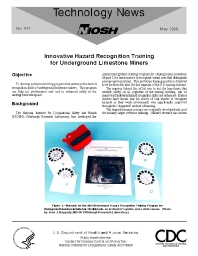 |
NIOSH, Pittsburgh Research Laboratory, has developed the Hazard Recognition Training Program for Underground Limestone to teach miners to recognize visual cues that distinguish poor ground conditions. This prototype training module is believed to be the first of its kind for this segment of the U.S. mining industry. The impetus behind this effort was to test the hypothesis that worker safety, in all segments of the mining industry, can be improved if individual hazard recognition skills are enhanced. Earlier studies have shown that the ability of coal miners to recognize hazards in their work environment was significantly improved through the "degraded" method of training. The degraded-image concept was originally developed and used for military target detection training. Military research has shown that pilots who were trained with less than ideal, or degraded, pictures, were more successful in subsequent identification of targets than those trained using ideal(or "highlighted") pictures of targets. Degraded images are scenes in which the subjects are partially hidden from view, observed from an eccentric angle, viewed through haze to dust, inadequately illuminated, or otherwise obstructed as to camouflage the target.
| Author(s): | NIOSH |
| Reference: | Pittsburgh, PA: U.S. Department of Health and Human Services, Public Health Service, Centers for Disease Control and Prevention, National Institute for Occupational Safety and Health, Technology News 471, 1998 May; :1-2 |
471 (PDF, 86 KB)